Low-power Bluetooth's new mesh network specification extends the original consumer-facing application and enhances its suitability for building automation applications

Support for Mesh networks enables low-power Bluetooth technology to enter a wider range of applications
Although Bluetooth® Low Energy (Bluetooth LE) technology has made significant progress as the underlying technology of the Internet of Things (IoT), it still has a weakness: because it is mainly used to support battery-powered peripherals and smartphones. Such as the communication of the central device, the technology cannot support the mesh network. Now, the Bluetooth mesh 1.0 specification eliminates this weakness.
Mesh networks allow devices ("nodes") in the network to communicate with one another without the need for a central hub device, and if needed, can relay packets via other nodes. Such systems enable greater communication range, flexibility and redundancy and are a prerequisite for all typical IoT wireless technologies. The main applications of Bluetooth mesh networks include enterprise lighting, back-end management for hosted beacons, and industrial monitoring.
Some companies, especially Silvair, believe that this demand is indispensable and have developed a proprietary mesh solution based on Bluetooth low energy technology to fill this gap. Surprisingly, the company's engineers played an important role in drafting the official Bluetooth mesh specification. The Bluetooth mesh specification has been officially released in July.
Not just for Bluetooth 5
As developers are familiar with the development of Bluetooth technology, it may be assumed that Bluetooth mesh is a new feature of Bluetooth 5 - but this is not the case. In fact, any Bluetooth-compatible (or higher) Bluetooth-compatible Bluetooth chip can support Bluetooth mesh through software updates. This allows a compatible Bluetooth wireless mesh network to be upgraded over the air using a low-power Bluetooth device with proprietary mesh networking.
This does not mean that the device does not need to update the application firmware. Bluetooth mesh is a new architecture with seven layers (bearing, network, lower and upper transport, access, base mode, and mode) built on the standard low-power Bluetooth physical layer (RF) (see Figure 1). When a node receives information, it propagates information from the lower layer Bluetooth low energy layer to the upper layer, through the bearer layer to the network layer. The network layer uses multiple inspection methods to decide to pass information to the upper layer of the protocol stack or to drop it (see 1 for more information on the capabilities of these layers).

Figure 1: The Bluetooth mesh protocol stack is located on the physical layer of Bluetooth low energy.
Source: Bluetooth Technology Alliance (SIG)
The Bluetooth mesh specification details four "nodes": "relay node", "low power node", "friend node" and "proxy node".
The relay node is able to resend the received data packets, and through this mechanism, the data packets can be quickly propagated throughout the network. The disadvantage of the relay mechanism is that the power consumption is increased because it relies on keeping the "awake" node. Although the power consumption of low-power Bluetooth in the mesh network configuration is much lower than other competing technologies, such a mode of operation cannot be sustained by battery alone. For applications such as smart lighting, this is not a disadvantage because the luminaire supplies power to the LED by accessing the backbone power supply system, but this may not be applicable to other non-backbone system power supply devices in the network, such as device switches.
To solve this problem, the Bluetooth network introduces a "Low Power Node" (LPN) that can be powered by battery or energy harvesting. The LPN works in conjunction with a "friend node", which is usually powered by the backbone system and thus can remain awake forever; these devices cache information sent to the LPN. The LPN switches to the "receive" mode according to the preset process table, receives the cached information, operates according to the instructions, and then quickly returns to the "sleep" state of power saving.
A "proxy node" allows a device that supports Bluetooth low energy but does not support Bluetooth mesh (such as a current smartphone) to connect to a Bluetooth Mesh network. Interaction is achieved through the Common Attribute Profile (GATT) interface of the node and the proxy device (see Figure 2).

Figure 2: A proxy node ("P") allows a low-power Bluetooth device (such as a smartphone) that does not support Bluetooth mesh to connect to a Bluetooth mesh network
Source: Bluetooth Technology Alliance (SIG)
Bluetooth mesh borrows from the GATT "profile" concept of Bluetooth technology, allowing the same information structure to be used in different situations. However, due to the distributed nature of mesh, the design of the configuration files of the two technologies is different. In order to avoid the GATT configuration file being mistaken for a mesh network configuration file, the mesh configuration file is called a "mode".
Bluetooth mesh 1.0 includes the "configuration", "heartbeat" and "health" basic modes, and the "mesh mode" is an extension of the basic mode, such as "general", "illumination", "sensor" and "scene". Similar to the GATT profile, users can also create custom base and mesh modes (for mode-related topics, readers are advised to read "Reference 1" for more details).
Lighting driver
Smart lighting is a pioneering application of wireless IoT technology, and many of the early Bluetooth network specifications were tailored for this application. The Bluetooth Technology Alliance (SIG) said in a blog post: "Bluetooth mesh will have a huge impact on commercial lighting applications."
That is to say, the integrated mechanism for intelligent lighting can easily support other critical applications such as beacons, secure networks, and heating, ventilation, and air conditioning (HVAC) networks. The key to these mechanisms is to communicate through "flooding", broadcasting each packet to other nodes in the network until it reaches the target node.
Three types of addressing can be used with flooding: "unicast" (used during initial node setup), "group", and "virtual" (used primarily by device manufacturers to 'tag' products). Among these, group addressing is best for everyday operations. A group address is a multicast address that represents one or more elements in a network. The SIG defines four "fixed group addresses", called "full proxy", "all friends", "full relay", and "full node", corresponding to the node types defined above.
In addition to these group addresses, installers are likely to assign dynamic group addresses during configuration to reflect the actual mesh layout. For example, a dynamic group address can be assigned to a fixture in each room in the building.
Flooding mesh and group addressing makes sense for major smart home applications, such as lighting. Flooding mesh allows the switch to send an "ON" command to the intelligent lighting group for rapid propagation over the network, with each node receiving the instruction and executing the instruction accordingly. The lights of the target group will light up quickly. The latency of flooding mesh can be much reduced compared to networks that require a hub to transmit separate instructions to each connected fixture, such as a star network.
The flooding architecture also brings other advantages, but it also includes some shortcomings. A major additional advantage is simplification, especially to limit communication to the three broadcast and scan channels of Bluetooth low energy technology (remember that this technology has a total of 40 frequency channels). However, such a disadvantage is that the bandwidth is reduced because management communication is required to prevent packets from exceeding these channels.
This specification includes several mechanisms to mitigate congestion on broadcast and scan channels. The first is to define a specific data packet, which is a "Time-To-Live" (TTL) counter that counts the number of relay transmissions. After the number of defined steps is satisfied, the relay transmission will not continue.
For example, setting the TTL counter to 3 allows a packet to be passed up to three times from its origin and then not re-propagated.
The second mechanism to prevent congestion is the message cache of the packet. After the entire mesh is transmitted, the packet will eventually form a cache—the cache can safely assume that the packet does not have to propagate at the current node. The "optional relay" feature can also limit mesh congestion. By turning off the relay, the node can receive the packet without transmitting it. Optional trunking adds complexity—because designers must compromise trade-offs for mesh flexibility and bandwidth consumption—which can improve overall mesh performance.
Safety first
Bluetooth mesh brings Bluetooth technology deeper into IoT – making security critical. Therefore, Bluetooth mesh designers must ensure that the network, applications, and devices are all secure and cannot be illegally shut down or restricted. For Bluetooth mesh, security features are not optional, but mandatory.
This mandatory method starts with "configuration", which is the process of turning an external device into a mesh network node, which can be implemented by an app on a smartphone or tablet. There are five steps in this process: broadcast (indicating that a mesh can be added), invitation (from a provisioning device), public key exchange, authentication, and session key exchange (security to ensure data configuration).
The configuration process is highly secure, and the packets are then encrypted end-to-end via AES-128 with additional AES-128 encryption between each relay for added privacy. In addition, the encryption key is periodically refreshed to detect and combat "replay attacks."
For more information on Bluetooth mesh please visit the Nordic website and the DevZone forum. Nordic's new nRF5 software development kit (SDK) for mesh allows developers to design Bluetooth mesh applications using the company's nRF51 and nRF52 family of SoCs. Nordic's Bluetooth mesh protocol stack implementation also includes some useful features that are not included in the Bluetooth mesh 1.0 specification.
This is a kind of healthy vape, zero nic, and is beneficial for the body.
Features of Disposable Vitamin B12 E-cigarette
1. Mini Colorful charming disposable pen;
2. Various flavors for your choice;
3. Could also use for thin and medium CBD oil;
4. Custom logo & Package;
5. No leaking, no burning
6. Top Filling by hand and oil filling machine
vitamin b12 vape pens no nic, vitamin e cig b12, vitamin b12 vape pens, vitamin e-cigarette kit, vitamin e-cigarette without nic
Ningbo Autrends International Trade Co.,Ltd. , https://www.supervapebar.com